
For all you number crunchers out there, products in the latest crop of spreadsheet applications have leaped to new heights of functionality. While continuing to calculate and process data, create charts and graphs, and evaluate layout presentation, the following spreadsheet programs also introduce sophisticated workgroup integration as well as novel tools for the Internet.
| Suitability to Task: Spreadsheets | |||
|---|---|---|---|
| Corel Quattro Pro 7 | Microsoft Excel 97 | Lotus 1-2-3 97 | |
| Application and model building | Excellent | Excellent | Excellent |
| Charting | Good | Excellent | Good |
| Worksheet presentation | Excellent | Excellent | Excellent |
| Applications development | Good | Excellent | Good |
| Workgroup integration | Poor | Good | Excellent |
| Internet tools | Fair | Excellent | Good |
Analysis and model building refers to the program's tools for calculating and processing data, and charting concerns the program's ability to build graphs. For worksheet presentation, we evaluate layout and style controls. Under applications development, we look at the spreadsheet's programmability. Workgroup integration concerns the tools for creating, distributing, and reviewing spreadsheets in a group. Internet tools refers to the methods used for gathering data from the Internet and posting information to it.
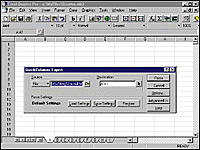
|
| Corel Quattro Pro 7 |

|
| Click here to indicate the kind of text you're importing.
|

|
| Use these fields in Corel Quattro Pro 7's new QuickColumns Expert to
specify source file and worksheet destination. |
Corel Corp.
Corel Quattro Pro 7
In its early days, Quattro Pro succeeded by being completely compatible with 1-2-3 while staying several steps ahead of Lotus in the features race. Indeed, many worthwhile spreadsheet innovations appeared first in Quattro Pro, such as the ability to link worksheets in the DOS environment and the tabbed notebook metaphor we now take for granted in Windows. But now, as the product has been handed off from Borland to Novell to Corel, Quattro Pro has lost its aggressive spirit, at least temporarily.
Corel Quattro Pro 7, the first version to appear under Corel's banner, bears a redesigned menu system that makes it look and feel more like its suitemates WordPerfect and Presentations. Corel has also added support for PerfectScript (Corel's cross-application scripting language) and supplied equivalents to some recent 1-2-3 and Excel features: data mapping, support for Notes F/X, simplified text importing, the option of plain-English help inquiries, and the catching of common spelling errors on the fly.
Like Excel and 1-2-3, Quattro Pro can open tables from World Wide Web, FTP, and Gopher sites. But your rights are read-only, so you cannot write information back to the Internet. Quattro Pro doesn't preserve hyperlinks in downloaded HTML data as Excel does, but you can create links by typing a URL as a formula into a cell. With a click on the standard toolbar, you can also create an on-screen macro button that updates the worksheet with information from a URL. And with a bit of PerfectScript code, you can create parameterized Web queries comparable with those available in Excel and 1-2-3.
PerfectScript is now more tightly integrated into Quattro Pro, allowing developers to write applications that link Quattro Pro with other members of the suite. For everyday productivity macros, you can set the recorder to transcribe your work in PerfectScript, or you can record and edit the older Quattro Pro macro language.
With PerfectScript and a little programming expertise, you can also easily write your own custom functions, something that was beyond most users' skills in earlier versions. But you may not need to do so, because this release adds about 100 items to the library, including hyperbolic trigonometry functions and new bond-calculation functions.
Quattro Pro's most serious omissions concern workgroup support. The application does include a send command, which allows you to send a workbook as an attachment to a message. (Quattro Pro supports Digital Teamlinks, Novell GroupWise 4.1, WordPerfect Office 4.0, and all mail systems that use CMC or MAPI standards). But the program has no provision for sequential mailing and offers no way to send only a particular worksheet range. The consolidate command allows you to reassemble contributions from workgroup members, but it's not as easy to use as you'd like and is not as versatile as Excel's merge workbooks commandor 1-2-3's TeamConsolidate command. Spreadsheet users who usually work collaboratively will be apt to find Quattro Pro frustrating.
For those who work primarily on their own, Quattro Pro may be a perfectly suitable number cruncher. But compared with the offerings from other vendors, it's just not the fire-breather it once was.
Corel Quattro Pro 7. List price: $99.00; upgrade, $49.95. Requires: 486-based PC or better, 16MB RAM, 30MB hard disk space, Microsoft Windows 95 or later. Corel Corp., Ottawa, Ontario, Canada; 800-772-6735, 613-728-3733; fax, 613-728-9790; www.corel.com.

|
| Microsoft Excel 97 |
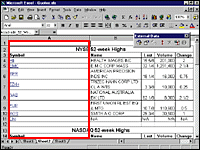
|
| You click here to edit Microsoft Excel 97's Internet Query (IQY)
file. |
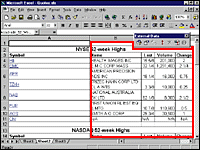
|
| In order to refresh a particular data item, you click here. |
Microsoft Corp.
Microsoft Excel 97
 The principal competitors facing Microsoft Excel 97 are Microsoft
Excel 95 (also known as Excel 7) and Microsoft Excel 5. Convincing
current customers to upgrade has become Microsoft's primary goal for
Excel, toward which end the company has equipped the latest version
with a well-rounded set of improvements.
The principal competitors facing Microsoft Excel 97 are Microsoft
Excel 95 (also known as Excel 7) and Microsoft Excel 5. Convincing
current customers to upgrade has become Microsoft's primary goal for
Excel, toward which end the company has equipped the latest version
with a well-rounded set of improvements.
Users who want to fetch data from the Internet or from a corporate intranet can take advantage of a new query feature. A Web query, coded in a plain-text Internet Query (IQY) file, attaches itself to Excel's Data menu; it can contain parameters for obtaining particular data from a Web site (a set of stock symbols, for example) or can prompt you for specifics when you make a Web connection. Excel comes with four sample IQY files, and others are available on Microsoft's Web site. (Quattro Pro and 1-2-3 can also generate parameterized Web queries, via their macro languages.)
To further the use of Web queries, Microsoft has provided support for some new, spreadsheet-specific HTML tags. As a result, developers designing sites with Excel users in mind can feed Web-query target fields into an Excel PivotTable or a filtered list. Like 1-2-3, Excel now allows reading at and writing to Internet sites, and it includes a special toolbar to facilitate Web browsing. In addition, a new insert hyperlink command lets you plant links to the Web or local files in worksheet cells.
On the workgroup front, Microsoft has adopted a model that explicitly supports simultaneous file access for workers both on- and off-site: Excel permits multiple users to edit a shared file simultaneously. (By contrast, 1-2-3 restricts all but one user to read-only rights.) When different editors enter conflicting changes to a document, Excel either accepts the last one or displays a dialog box that lets the user who made the last change decide. A change-history feature records every edit with a user name and date, allowing an editor to restore original cell values and letting those working alone track their own revisions. But Excel still lacks an easy-to-use, versatile scenario and version manager comparable to 1-2-3's.
Users can merge copies of a shared workbook with a new merge workbooks command. Excel resolves any conflicts using the same rules it employs for changes to a single file.
Excel's charting interface now fully aligns the menu system and chart wizard, so that each wizard dialog box has an exact menu counterpart. As a result, you can now employ the menu system for both creating and editing charts.
In addition, PivotTables can now include calculated fields, and an external query operates as a separate thread, allowing you to continue working while tables are externally refreshed. Persistent formatting, structured selections, and correct sorting of dates take care of some petty irritations in previous versions' pivot tables.
You can also select charts for editing with a single click, and a clever bounding box appears around those worksheet cells that contribute to a selected data series, allowing you to expand, contract, or modify the series by simply dragging the box or its fill handle.
Microsoft Excel 97 is clearly the most richly endowed spreadsheet that you can purchase. But Excel 95 is arguably the second most richly endowed. Whether the new release is a compelling upgrade for you depends on whether you need its new features.
Microsoft Excel 97. Street price: $340; upgrade, $110. Requires: 486-based PC or better, 8MB (for Microsoft Windows 95) or 16MB (for Windows NT 3.51 or later) RAM, 22MB hard disk space, Windows 95 or Windows NT 3.51 or later. Microsoft Corp., Redmond, WA; 800-426-9400, 206-882-8080; fax, 206-936-7329; www.microsoft.com.
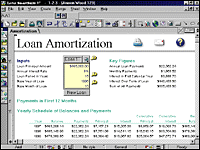
|
| 1-2-3 97 |

|
| These outline buttons let you control the amount of detail shown on
the worksheet. |
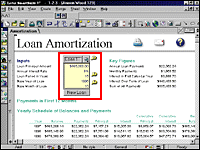
|
| Versions store alternative loan parameters in this range. |
Lotus Development Corp.
1-2-3 97
With 1-2-3 97, Lotus continues its quest to win over the well-connected spreadsheet user. The most substantial improvements are a set of new Internet-related features and the implementation of Lotus's Team Computing commands. New connectivity tools, an improved user interface, and the long-awaited LotusScript (Lotus's BASIC-like cross-application scripting language) are also among 1-2-3's latest enhancements.
Like Excel, 1-2-3 can now read files from and write files to Web and FTP sites. An Internet button in the File dialog brings up a new dialog, where users can select from recently used URLs, supply proxy information, enter passwords for FTP sites, and so on. When publishing a table to the Internet, 1-2-3 gives you the option of previewing the HTML rendition off-line. And if you're adept at LotusScript programming, you can set up reusable Web queries for such things as updating stock prices and currency exchange rates. 1-2-3 ships with sample code to show you how.
A new SmartIcon palette provides shortcuts for these Internet activities as well as buttons for connecting to Lotus's own Web sites and a Web-search site. The toolbar includes a button that passes selected worksheet text as a parameter to the Yahoo! search facility, as well as another button that creates a worksheet link so you can invoke a favorite Web site. Hyperlinks imported to the worksheet from the Web, however, arrive as inert text.
Although their design is unnecessarily complex, 1-2-3 97's new team computing commands provide a welcome set of workgroup tools: TeamMail allows you to send messages with or without embedding the current file, while TeamReview allows you to send ranges (including alternative versions of ranges) as well as merge comments and edits from recipients back into the original spreadsheet. And TeamConsolidate lets you store individual worksheet pages in Lotus Notes 4.1 or later to help you replicate and reconcile documents.
The most important changes to 1-2-3's user interface are the adoption of the Lotus InfoBox, a modeless tabbed dialog that simplifies formatting changes by updating the worksheet immediately, and a redesign of Version Manager that will make this valuable feature accessible to a wider range of users. And a clever new totaling feature lets you add up columns and rows by simply typing the word total into a cell. In addition, 1-2-3 users can use Approach to create dynamic crosstabs of data stored within a 1-2-3 database table.
With LotusScript, you can now add your own functions to 1-2-3's library. Backward compatibility is somewhat less complete than in earlier versions. The classic menu box remains, of course, but about 20 of the verbs in Release 5's macro language do not exist in 1-2-3 97. (Lotus contends this version made them obsolete.) And the C API for add-in developers is gone, forcing third parties either to rewrite their add-ins in LotusScript or to drop support for 1-2-3. Although these bumps in the upgrade path for developers and add-in vendors somewhat diminish the product's appeal, Lotus has otherwise designed an attractively refurbished 1-2-3.
1-2-3 97. Street price: $329; upgrade, $105. Requires: 486-based CPU or better, 8MB (for Microsoft Windows 95) or 16MB (for Windows NT 4.0) RAM, 25MB hard disk space, Windows 95 or Windows NT 4.0. Lotus Development Corp., Cambridge, MA; 800-426-7682, 617-577-8500; fax, 617-693-3512; www.lotus.com.
 ScreenDemo
ScreenDemo